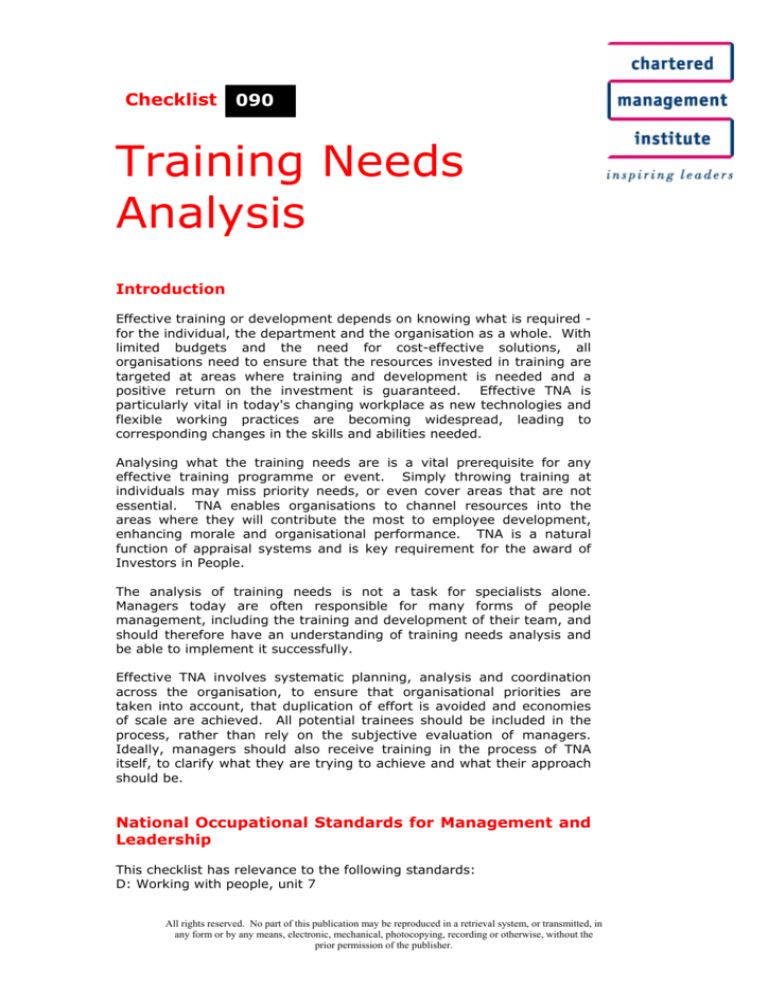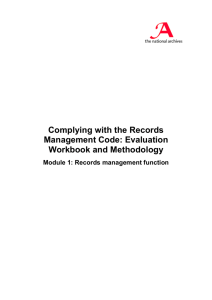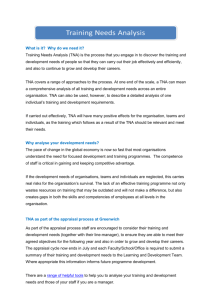
Checklist
090
Training Needs
Analysis
Introduction
Effective training or development depends on knowing what is required for the individual, the department and the organisation as a whole. With
limited budgets and the need for cost-effective solutions, all
organisations need to ensure that the resources invested in training are
targeted at areas where training and development is needed and a
positive return on the investment is guaranteed. Effective TNA is
particularly vital in today's changing workplace as new technologies and
flexible working practices are becoming widespread, leading to
corresponding changes in the skills and abilities needed.
Analysing what the training needs are is a vital prerequisite for any
effective training programme or event. Simply throwing training at
individuals may miss priority needs, or even cover areas that are not
essential. TNA enables organisations to channel resources into the
areas where they will contribute the most to employee development,
enhancing morale and organisational performance. TNA is a natural
function of appraisal systems and is key requirement for the award of
Investors in People.
The analysis of training needs is not a task for specialists alone.
Managers today are often responsible for many forms of people
management, including the training and development of their team, and
should therefore have an understanding of training needs analysis and
be able to implement it successfully.
Effective TNA involves systematic planning, analysis and coordination
across the organisation, to ensure that organisational priorities are
taken into account, that duplication of effort is avoided and economies
of scale are achieved. All potential trainees should be included in the
process, rather than rely on the subjective evaluation of managers.
Ideally, managers should also receive training in the process of TNA
itself, to clarify what they are trying to achieve and what their approach
should be.
National Occupational Standards for Management and
Leadership
This checklist has relevance to the following standards:
D: Working with people, unit 7
All rights reserved. No part of this publication may be reproduced in a retrieval system, or transmitted, in
any form or by any means, electronic, mechanical, photocopying, recording or otherwise, without the
prior permission of the publisher.
Definition
A training need is a shortage of skills or abilities, which could be reduced or
eliminated by means of training and development.
Training needs hinder
employees in the fulfilment of their job responsibilities or prevent an organisation
from achieving its objectives. They may be caused by a lack of skills, knowledge
or understanding, or arise from a change in the workplace.
Training needs analysis identifies training needs at employee, departmental or
organisational level in order to help the organisation to perform effectively. The
aim of training needs analysis is to ensure that training addresses existing
problems, is tailored to organisational objectives, and is delivered in an effective
and cost-efficient manner.
Training needs analysis involves:
•
•
•
monitoring current performance using techniques such as observation,
interviews and questionnaires
anticipating future shortfalls or problems
identifying the type and level of training required and analysing how this
can best be provided.
Action checklist
Training needs can be sorted broadly into three types:
• those you can anticipate
• those that arise from monitoring
• those which result from unexpected problems.
1.
Ensure that the identification of training needs is integrated across
the organisation
Training needs discovered in one department are likely to exist in others. It is
pointless for individual managers to throw their own limited resources at each
problem as it arises, duplicating efforts and dissipating energy.
Most organisations have a personnel function which organises training delivery.
You may not be the person responsible for coordinating the system, but you have
an important role to play in collecting the best information you can on the training
needs of the people who work for you and passing it up the line.
At the very least, liaise with other managers to aggregate training needs
information, so that a range of appropriate training and development activities
can be planned.
2.
Anticipate future needs
Training needs often appear at the organisational or activity level. For example,
the arrival of a new office or workshop equipment, may well have training
implications for everyone using it.
Alternatively, an organisation that decides to enhance its level of customer
service as part of a corporate strategy knows that a programme of training and
development is essential for its success.
All rights reserved. No part of this publication may be reproduced in a retrieval system, or transmitted, in
any form or by any means, electronic, mechanical, photocopying, recording or otherwise, without the
prior permission of the publisher.
3.
Develop monitoring techniques
Some training needs can go unnoticed because they creep up on the organisation
gradually. Active monitoring systems are essential to spot these and can make a
valuable contribution to the process of collecting information on performance
gaps and training needs.
Variance analysis is one approach to monitoring. This sounds technical but is a
simple tool used by managers to monitor budgets. It translates neatly to the
identification of training needs. When a budget is agreed, expected monthly
expenditure is detailed. Any major variance from the forecast - upwards or
downwards - triggers an investigation into why it happened and what the
implications will be.
In TNA, the budget numbers are replaced by performance standards and
indicators which are as specific as possible. It could be, for instance, that even in
a 'soft' issue like customer satisfaction, a standard can be set that says 95% of
customers feel they received excellent service (the 5% allows for the small
number who will always find fault, and those who always rate an experience as
less than 100%, on principle). Carrying out customer satisfaction surveys allows
you to measure any deviation.
Asking questions at appraisal interviews can act as a form of survey, as the
same issues are being addressed throughout the organisation.
Identifying
training needs is one purpose of appraisal.
In addition to training needs that emerge as a result of an appraisal interview, a
worthwhile approach to investigating one-off problems is to interview staff and
customers. Regularly ask a random sample of people for their views on the same
set of questions relating to general performance - for instance customer
satisfaction levels.
4.
Investigate unexpected problems with care
Monitoring will indicate where gaps and problems exist. However, it is possible to
make the wrong assumption when faced with a particular set of circumstances.
For instance, unusually rapid staff turnover in a small section may lead to a
conclusion that unsocial hours worked there are the issue. However, staff exit
interviews may indicate that turnover is a result of cramped working conditions
and poor ventilation – issues that training cannot resolve, even though the
monitoring process has helped identify the problem.
On the other hand, it could be that:
•
•
the behaviour of the section head is the root cause
errors at the recruitment stage mean that unsuitable people are being
taken on.
In either of these cases there is a training need - in the first case with the section
head and in the second with those doing the recruiting. This could include you.
5.
Identify the level of need
It could be that a training need is limited to a single individual or activity but it is
more likely to be relevant for a number of people, a whole department or across
the organisation. For example, if the organisation traditionally treats customers
as a nuisance, it needs to change its overall approach. In this case, giving one or
All rights reserved. No part of this publication may be reproduced in a retrieval system, or transmitted, in
any form or by any means, electronic, mechanical, photocopying, recording or otherwise, without the
prior permission of the publisher.
two people training would address the training need at the wrong level;
organisation development is needed rather than individual training sessions.
6.
Consider what type of training will be most appropriate
Consider whether the training needs can be met by using internal expertise or
whether external assistance will be necessary. Will informal training be suitable
or are formal training courses required? Take into account the number of people
to be trained and the resources available.
7.
Take appropriate action
If the training needs are within your own span of control, probably at individual or
maybe at activity level, you can plan action to meet the needs. If the needs are
broader, you will need to make recommendations and proposals to those
responsible for planning and implementing training interventions in your
organisation. This may involve drawing up a report specifying the training needs
you have identified, your recommendations for meeting them and the expected
benefits of the training.
Managers should avoid:
•
•
•
•
making snap assumptions about performance problems
organising training without first establishing a need
taking a one size fits all approach. A course which one person found
helpful will not necessarily meet the needs of a diverse group of individuals
focusing on obvious training needs at the expense of those which may only
be discovered through systematic monitoring.
Additional resources
Books
Making training and development work: a best practice guide, Thomas N
Garavan, Carole Hogan, Amanda Cahir O’Donnell
Cork: Oak Tree Press, 2003
Learning needs analysis and evaluation, 2nd ed., Francis Bee & Roland Bee
London: Chartered Institute of Personnel and Development, 2003
Training needs analysis in a week, Tom Holden
London: Hodder & Stoughton, 2002
This is a selection of books available for loan to members from the Management
Information Centre. More information at: www.managers.org.uk/mic
Internet resources
Business Link: www.businesslink.gov.uk
Go to Skills and Training under Employing People for a guide on how to fit training
to your needs, which includes guidance on identifying training needs.
businessballs.com: www.businessballs.com
Templates for assessing skill needs are included under training needs analysis.
Revised November 2006
All rights reserved. No part of this publication may be reproduced in a retrieval system, or transmitted, in
any form or by any means, electronic, mechanical, photocopying, recording or otherwise, without the
prior permission of the publisher.








